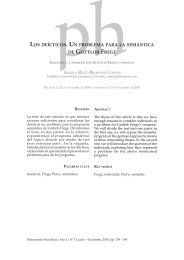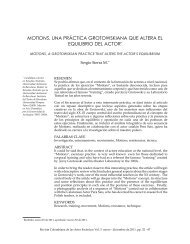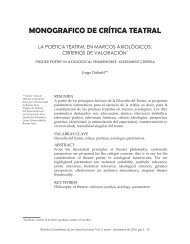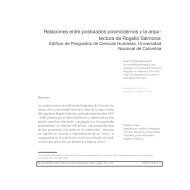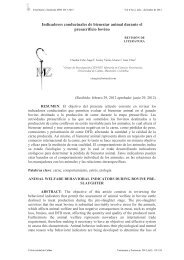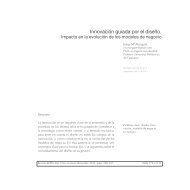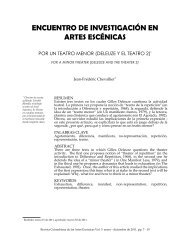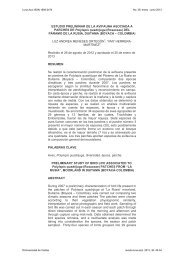VIRTUAL WORLDS , FICTION, AND REALITY
VIRTUAL WORLDS , FICTION, AND REALITY
VIRTUAL WORLDS , FICTION, AND REALITY
Create successful ePaper yourself
Turn your PDF publications into a flip-book with our unique Google optimized e-Paper software.
Virtual worlds, fiction, and reality<br />
Mundos virtuales, ficción y realidad<br />
Ilkka Maunu nIInIluoto<br />
University of Helsinki, Finland. discufilo@ucaldas.edu.co<br />
RecIbIdo el 13 de julIo de 2011 y apRobado el 30 de agosto de 2011<br />
resumen<br />
Mi objetivo en este artículo es plantear<br />
y discutir algunas de las preguntas<br />
filosóficas sobre la Realidad Virtual (RV).<br />
El problema fundamental se refiere a<br />
la naturaleza ontológica de la realidad<br />
virtual: ¿es real o ficticia? ¿La RV es<br />
comparable a ilusiones, alucinaciones,<br />
sueños, o mundos de ficción? ¿Son todas<br />
las categorías filosóficas tradicionales<br />
suficientes para darnos la comprensión<br />
del fenómeno de la RV? Para abordar<br />
estas cuestiones, emplearé como mis<br />
herramientas filosóficas la semántica de<br />
mundos posibles y las teorías lógicas<br />
de la percepción y la imaginación. Mi<br />
conclusión principal es que la RV es<br />
comparable a una imagen en 3-D que<br />
puede ser vista desde el interior.<br />
Palabras claVe<br />
ficción, alucinación, imaginación,<br />
percepción, realidad, realidad virtual.<br />
abstract<br />
Discusiones Filosóficas. Año 12 Nº 19, julio – diciembre, 2011. pp. 13 - 28<br />
My aim in this paper is to raise and discuss<br />
some philosophical questions about Virtual<br />
Reality (VR). The most fundamental<br />
problem concerns the ontological nature of<br />
VR: is it real or fictional? Is VR comparable<br />
to illusions, hallucinations, dreams,<br />
or worlds of fiction? Are traditional<br />
philosophical categories at all sufficient to<br />
give us understanding of the phenomenon<br />
of VR? In approaching these questions, I<br />
shall employ possible world semantics<br />
and logical theories of perception and<br />
imagination as my philosophical tools. My<br />
main conclusion is that VR is comparable<br />
to a 3-D picture which can be seen from<br />
the inside.<br />
Key words<br />
fiction, hallucination, imagination,<br />
perception, reality, Virtual Reality.<br />
* This article is a revised version of a paper originally published in IO Internet Magazine, vol. 3:<br />
Virtual Environments, ed. by Pauline von Bonsdorff, Summer 2006.
Ilkka Maunu Niiniluoto<br />
What is Virtual Reality?<br />
In his book Virtual realism (1998), Michael Heim states that virtual<br />
reality is a “technology” or “an emerge field of applied science” (4).<br />
This is, indeed, one way of looking at VR: computer programs, data<br />
gloves and helmets are used to produce artificial sensory inputs; these<br />
inputs resemble the participant’s normal interface with the physical<br />
environment and thus he feels himself immersed in a new “reality”.<br />
Hence, VR is a method of constructing and designing new kinds of<br />
artefacts.<br />
As a technological activity, VR can be assessed by various criteria<br />
which include economy, efficiency, aesthetics, ergonomics, ecology,<br />
ethics, and social effects (see Niiniluoto 1997). For example, from the<br />
aesthetic viewpoint VR is a new form of media art: by using methods<br />
of interactive design it helps to produce works and experiences with<br />
interesting aesthetic qualities. From the ergonomic perspective, intense<br />
occupation with extraordinary sensory stimulations may lead to a<br />
state of nausea where images of virtual worlds and the actual world<br />
are confused; this is called the Alternate World Syndrome (AWS) and<br />
Alternate World Disorder (AWD) by Heim (1998).<br />
In Virtual Reality (1991), Howard Rheingold points out that VR can be<br />
employed for the purposes of entertainment, but it may also function as<br />
a way of escape and addiction. These ethical and social concerns are also<br />
discussed by Heim who suggests that “virtual realism” could mediate<br />
between “naive realists” (who blame computers for all social evils)<br />
and “network idealists” (who promote all new forms of computerized<br />
technology).<br />
Instead of aesthetics, ergonomics, and ethics, my main philosophical<br />
concern in this paper is ontological. Since Jaron Lanier coined the term<br />
“virtual reality” in 1986 and William Gibson spoke of “cyberspace” in<br />
his novel Neuromancer in 1984, this new field has been characterized in<br />
the United States and Japan by such terms as “virtual environment”,<br />
“synthetic environment”, “virtual worlds”, “tele-presence”, and “teleexistence”.<br />
Notions like “reality”, “world”, “environment”, “space”,<br />
“presence”, and “existence” are ontological categories in the sense that<br />
they refer to the most general structures of what is real or exists. On the<br />
other hand, they are here qualified by phrases like “virtual” and “tele”<br />
which imply some kind of deviation or distance from reality.<br />
14 Discusiones Filosóficas. Año 12 Nº 19, julio – diciembre, 2011. pp. 13 - 28
VIRtual woRlds, fIctIon, and RealIty<br />
Today there is a tendency of calling “virtual” almost anything connected<br />
with computers: a “virtual library” allows multimedia works to be read<br />
in the Web, and a “virtual university” offers courses in Internet in an<br />
electronic form. The original Latin term virtus meant human powers<br />
and potentiality, and later it referred to human “virtues”. The Concise<br />
Oxford dictionary defines “virtual” as “that is such for practical purposes<br />
though not in name or according to strict definition”, and Heim defines<br />
it as “not actually, but as if” (op. cit. 220). In this as-if sense, terms like<br />
“virtual velocity” are comparable to expressions like “semiofficial”,<br />
“pseudoscience”, and “artificial leg” which imply that something is<br />
only half, falsely, seemingly, non-naturally, or non-genuinely so-and-so.<br />
In the same way as we may ask whether artificial intelligence merely<br />
pretends or “really” is intelligence (cf. the distinction between weak and<br />
strong AI in Searle, 1984), we may raise the question whether virtual<br />
reality is “really” real or not.<br />
Even though Heim warns that VR is “not synonymous with illusion or<br />
mirage or hallucination”, and “not a state of consciousness or a simulated<br />
drug trip” (4), the idea of “as-if reality” clearly has a connection to<br />
the old philosophical distinction between appearance and reality.<br />
Therefore, our analysis of the ontological status of VR has to proceed<br />
by comparing it to some important types of phenomena discussed in<br />
traditional epistemology.<br />
Reality vs. Fiction<br />
According to Karl Popper’s (1979) useful classification the domain<br />
of reality can be divided into three parts. World 1 consists of physical<br />
objects and processes, World 2 contain mental states and events within<br />
a human mind and World 3 include human-made artefacts and socially<br />
produced institutions. Thus stones, atoms, and fields of force belong<br />
to World 1; beliefs, wishes, feelings and emotions belong to World 2;<br />
works of art, scientific theories, propositions and other meanings of<br />
linguistic expressions, natural numbers and social institutions belong<br />
to World 3. In the traditional terminology, the popperian three-fold<br />
ontology corresponds to the division between nature, consciousness,<br />
and culture & society.<br />
Physical entities exist in space and time, and they are in causal interaction<br />
with each other. Physicalists take these features to be the general criteria<br />
of reality or actual existence (see Devitt 1991). Therefore, they either<br />
15
Ilkka Maunu Niiniluoto<br />
eliminate World 2 entities or reduce them to physical states of human<br />
brains or bodies. Similarly, most physicalists are nominalists who either<br />
reject all World 3 entities as philosophically illegitimate abstractions<br />
or attempt to reduce them via subjective World 2 entities to World 1.<br />
Conversely, the subjective idealists (e.g., solipsists and phenomenalists)<br />
suggest that the whole of reality should be reduced to World 2, while<br />
the objective idealists take as the primary reality some abstract entities like<br />
Plato’s forms or Hegel’s objective spirit. In contemporary philosophy,<br />
idealism has gained some support in new linguistic and social forms:<br />
the social constructivists claim the world is a “social construction” arising<br />
from human practices and discourses.<br />
In my view, the most plausible interpretation of Popper’s ontology is<br />
emergent materialism which differs both from physicalism and idealism<br />
(see Niiniluoto 1999a-2006). Worlds 2 and 3 have historically developed<br />
from the primary World 1 through biological and cultural evolution,<br />
and their existence continues to be dependent on the support provided<br />
by the material reality. However, as emergent levels of reality, Worlds<br />
2 and 3 have gained a relative independence from World 1: they are<br />
able to be in a complex mutual interaction with World 1, and they have<br />
their own characteristic features and lawlike regularities that cannot be<br />
derived from true theories about the physical world.<br />
Emergent materialism accepts ontological realism in two different senses.<br />
In the first place, against nominalists, it admits the reality of some<br />
abstract entities (like concepts, propositions, numbers, symphonies)<br />
which are different from their physical documentations (like written and<br />
uttered words and sentences) and mental representations (like ideas and<br />
thoughts). However, against platonist versions of realism, such World 3<br />
entities are regarded as human-made social constructions. Secondly, a<br />
realist may accept that human beings can causally interact with physical<br />
nature, and that World 1 can be structured or “carved up” in different<br />
ways by means of various conceptual frameworks; in this sense one may<br />
speak about “worldmaking” with Nelson Goodman (1978). Still, unlike<br />
Goodman and the recent versions of social constructivism, the realist<br />
asserts that World 1 exists independently of human minds, languages,<br />
and societies.<br />
Charles Peirce defined “the real” as “that whose characters are<br />
independent of what anybody may think them to be” (5.311 5.405).<br />
This definition allows for the existence of real possibilities: for example,<br />
16 Discusiones Filosóficas. Año 12 Nº 19, julio – diciembre, 2011. pp. 13 - 28
VIRtual woRlds, fIctIon, and RealIty<br />
fragility is a real dispositional property of a glass window, since it<br />
would be manifested in a regular way under certain conditions quite<br />
independently of what we may think about the matter. In this sense,<br />
powers, dispositions, tendencies, and propensities may be real even<br />
when they are not actualized.<br />
As Peirce himself suggested, his definition gives us a criterion for<br />
distinguishing reality and fiction. For example, if I am thinking about a<br />
golden mountain, then my mental state of thinking-a-golden-mountain<br />
is a real fact about World 2, but the golden mountain is only a figment of<br />
my imagination. When Leo Tolstoy published his novel Anna Karenina a<br />
public work in World 3 was created, but Anna Karenina as a character<br />
in the novel remains a fictional entity. Her properties include only those<br />
implied by Tolstoy’s novel. In contrast, natural numbers as mathematical<br />
constructions are real in Peirce’s sense: any sufficiently large number<br />
which has never been investigated in arithmetic still has properties like<br />
being odd or even – even when we don’t yet know that.<br />
Around the year 1900 a famous controversy took place between Alexius<br />
Meinong and Bertrand Russell. Meinong suggested that all names and<br />
definite descriptions, including empty ones (like ‘the present king of<br />
France’) and fictional ones (like ‘Donald Duck’), should be understood<br />
to have referents, where the entities serving in this role are “real” but<br />
not necessarily actual or existing. Russell showed how discourse with<br />
such empty descriptions can be semantically interpreted as typically<br />
consisting of false statements – without assuming strange Meinongian<br />
entities. In terms of the possible world semantics there may be non-actual<br />
and unreal possible worlds where presently France has a king or Anna<br />
Karenina is living. Fictional entities are thus denizens of possible<br />
worlds. What is today called “Meinong’s jungle” (see Routley 1980),<br />
is a composite of all objects and states of affairs which are logically or<br />
conceptually possible.<br />
Perception and imagination<br />
The classical problem of epistemology concerns our possibility of<br />
obtaining knowledge about external reality. Given Plato’s definition of<br />
knowledge as justified true belief and Descartes’ distinction between<br />
mind and matter, we may ask on what conditions our beliefs are reliable<br />
and correct representations of material facts. Stated in other terms, this<br />
is a problem about relations between mental states in World 2 and facts<br />
17
Ilkka Maunu Niiniluoto<br />
in World 1. Another problem of epistemology concerns our knowledge<br />
of the human mind – this involves relations between states in World 2.<br />
A paradigm case of knowledge is perception. Suppose that I see a tree.<br />
In the case of veridical perception, this means that there is really a tree<br />
in front of me, that it causally influences my sensory apparatus, and the<br />
received visual data give rise to a perceptual judgment of the form ‘This<br />
is a tree’. The tree exists in World 1, the mental state of seeing the tree in<br />
World 2. This causal account of perception can be combined with Ludwig<br />
Wittgenstein’s famous thesis that all seeing is seeing as. In order to see<br />
the thing in front of me as a tree, and thus to form the judgement ‘This<br />
is a tree’, it is presupposed that I have already learnt the concept ‘tree’.<br />
In Jaakko Hintikka’s (1975) logic of perception, a statement of the<br />
form ‘I see b as an F’ can be interpreted as claiming that in all possible<br />
worlds compatible with what I see there is an object of type F in front<br />
of me, and this F-perception is caused by the object b existing in the<br />
actual world. Such an F-perception is veridical just in case the object b<br />
is really of type F.<br />
A visual illusion obtains when I see a real object but make a mistake in<br />
its character: I see b, which is not an F, as an F. To see a bush as a bear<br />
is a typical case of illusion. Many philosophers have defined illusions as<br />
false beliefs caused by sensations, but as Hintikka points out, there are<br />
conscious visual illusions where we are not deceived by what appears<br />
to us. I know that an oar does not bend in water but I cannot help seeing<br />
it as bent when I put it in water (cf. Niiniluoto 1982).<br />
When I see a star, the causal chain from the remote object to my<br />
perception may take millions of years. But even more complicated cases<br />
are obtained by allowing that the causal link is mediated by artificial<br />
technologies. Perhaps no one objects if I claim to see my wife through<br />
spectacles, a window, or even a mirror. But could I see her through a<br />
picture? If I am looking at a photo of John Wayne, or watching John<br />
Ford’s western The Searchers, do I see John Wayne? And if I am arranging<br />
a tele-seminar with my colleagues in London, do I see them from my<br />
video-conference room in Helsinki? As long as the causal chain is more<br />
or less mechanical and the signals causally transmit sufficiently correct<br />
information about the source, I am inclined to answer these question<br />
positively –in the same way as we are already accustomed to saying that<br />
we hear other persons (not only their recorded voice) on the telephone<br />
or radio. But if the picture is a painting of John Wayne made by an artist,<br />
18 Discusiones Filosóficas. Año 12 Nº 19, julio – diciembre, 2011. pp. 13 - 28
VIRtual woRlds, fIctIon, and RealIty<br />
then it seems more natural to construe the situation to be such that the<br />
object of my perception is the painting– and add that under certain<br />
circumstances a picture of X serves as an iconic sign of X in Peirce’s sense<br />
(see Niiniluoto 1999b). Icons are signs which are similar with their objects<br />
in some respects (cf. Niiniluoto 1987 Ch. 1). Thus, seeing a picture of X<br />
may indirectly give information about X as well. In particular, seeing a<br />
picture of X and directly seeing X may involve perceptual experiences<br />
closely resembling each other (cf. Gombrich Hochberg & Black 1972).<br />
Hallucination is usually treated as a limiting case of perception, since the<br />
person is convinced that he sees or hears something. If I am having a<br />
hallucination there is no object in front of me, or the “normal” causal link<br />
between reality and what I seem to perceive is missing. If it seems to me<br />
that I am seeing a pink elephant in my room, this deceptive appearance<br />
may be due to extreme nervous exhaustion or drug excitement of my<br />
brain functions.<br />
The logic of imagination can be developed along the same lines as the<br />
logic of perception by employing the possible world semantics (see<br />
Niiniluoto 1986). The statement ‘I imagine that p’ means that in all<br />
possible worlds compatible with what I imagine it is the case that p. Acts<br />
of imagination may be voluntary (fantasy, daydreaming) or involuntary<br />
(dreaming). Again we have statements of the form ‘I imagine b as an<br />
F’. Here b may be a real object, but then no direct causal link from b to<br />
the contents of my imagination exists: for example, I may imagine of<br />
my wife (who is in Helsinki) that she is coming to meet me during my<br />
trip to Rome, or in my dream I may discuss with my late father. But b<br />
may also be an imagined object. I may use private phantasy to create<br />
in my mind a person and then imagine that she is dancing with me. Or<br />
I may imagine that I am walking with some publicly known fictional<br />
character like Mickey Mouse.<br />
Appearance and reality<br />
The traditional distinction between appearance and reality can be directly<br />
applied to cases involving perceptual illusions (the real bush appears<br />
to me as a bear) and hallucinations (the pink elephant that I seem to<br />
see is not real). From my perceptual experience alone I cannot judge<br />
whether it is veridical or not. The sceptical question immediately arises:<br />
how can we ever be certain or justified in thinking that our perceptions<br />
correspond to reality?<br />
19
Ilkka Maunu Niiniluoto<br />
Some philosophers have found idealism attractive since it abolishes the<br />
distinction between appearance and reality: if no reality is hidden behind<br />
our observations, then scepticism becomes obsolete. The ancient sceptics<br />
had a more pragmatic attitude: follow the appearances in your everyday<br />
life and withhold all judgments about their reality (see Niiniluoto 2000).<br />
Immanuel Kant’s critical idealism accepts things in themselves behind<br />
phenomena but asserts that nothing but their existence can be known by<br />
human beings. Edmund Husserl’s phenomenology adopts the research<br />
programme of studying the-world-as-conceived-by-us and putting the<br />
external world-as-it-is-in-itself into brackets.<br />
However, a realist who accepts the three worlds ontology outlined above<br />
cannot avoid the problem of scepticism (cf. Niiniluoto 1999a). Moreover,<br />
he has to be ready to consider its most radical version: how can I know<br />
that I am even perceiving something rather than only seeing a dream?<br />
World literature contains many touching descriptions of situations<br />
where a person feels uncertain whether he is dreaming or not. “We are<br />
such stuff as dreams are made on, and our little life is rounded with a<br />
sleep”, Shakespeare exclaimed in The Tempest. In Hamlet, he described<br />
an alienated outsider, beset with a weakened sense of reality and a<br />
melancholic feeling of a shady dream-like existence. This ambiguous<br />
mood of mind was expressed by romantic poets of the 19th century<br />
in well-known verses Samuel Taylor Coleridge in Reality’s dark dream<br />
(1803):<br />
I know ‘tis but a dream, yet feel more anguish<br />
Than if ‘t were truth. It has often been so:<br />
Must I die under it? Is no one near?<br />
Will no one hear these stifled groans and wake me?,<br />
and Edgar Allan Poe (1845):<br />
All that we see or seem<br />
is but a dream within a dream.<br />
The same theme, treated as an epistemological rather than existential<br />
problem, has been discussed by philosophers ever since Plato’s<br />
dialogue Theaetetus. To refute the attempted definition of knowledge<br />
as perception, Socrates raises a question “you must often have heard<br />
persons ask”:<br />
20 Discusiones Filosóficas. Año 12 Nº 19, julio – diciembre, 2011. pp. 13 - 28
VIRtual woRlds, fIctIon, and RealIty<br />
How can you determine whether at this moment we are<br />
sleeping, and all our thoughts are a dream; or whether we<br />
are awake, and talking to one another in the waking state?<br />
Theaetetus replies:<br />
Indeed, Socrates, I do not know how it could be determined,<br />
for in both cases the facts precisely correspond; and there<br />
is no difficulty in supposing that during all this discussion<br />
we have been talking to one another in a dream.<br />
This thesis -viz. merely illusory, imagined, or dreamed experiences do<br />
not contain any observable feature that would distinguish them from<br />
“real” presentations- was called the Theaetetus theorem by Eino Kaila<br />
in 1958 (see Kaila 1979). Perhaps the most famous formulation of this<br />
“theorem” was given by René Descartes in his Meditations on the First<br />
Philosophy (1641). In exercising his method of universal doubt, Descartes<br />
ponders in his chamber:<br />
However, I must here consider that I am a man, and<br />
consequently that I am in the habit of sleeping and of<br />
representing to myself in my dreams those same things, or<br />
sometimes even less likely things, which insane people do<br />
when they are awake. How many times have I dreamt at<br />
night that I was in this place, dressed, by the fire, although<br />
I was quite naked in my bed? It certainly seems to me at the<br />
moment that I am not looking at this paper with my eyes<br />
closed; that this head that I shake is not asleep; that I hold<br />
out this hand intentionally and deliberately, and that I am<br />
aware of it. What happens in sleep does not seem as clear<br />
and distinct as all this. But in thinking about it carefully,<br />
I recall having often been deceived in sleep by similar<br />
illusions, and, reflecting on this circumstance more closely,<br />
I see so clearly that there are no conclusive signs by means<br />
of which one can distinguish clearly between being awake<br />
and being asleep, that I am quite astonished by it; and my<br />
astonishment is such that it is almost capable of persuading<br />
me that I am asleep now. (1968 96-97)<br />
The Theaetetus theorem does not deny that sometimes in dreaming I<br />
may have a strongly felt conviction that “this is only a dream”. Plato<br />
and Descartes were looking for a general criterion which would exclude<br />
all doubt about my state. But if a property F is proposed as a criterion<br />
21
Ilkka Maunu Niiniluoto<br />
of waking, in particular cases it is always possible to claim that I only<br />
dream that my experience has this property F.<br />
Kaila concluded that the Theaetetus theorem is valid. However, he<br />
argued that Descartes failed to distinguish logical doubt from empirical<br />
uncertainty: Even if it is always logically possible to doubt the reality of<br />
our impressions, we may still in fact be in some weaker sense empirically<br />
certain about their reality.<br />
Many philosophers have accepted the Theaetetus theorem for momentary<br />
experiences, but still they have suggested that the interrelations of<br />
sequences of experiences provide a criterion of reality. In the Sixth<br />
Meditation, Descartes concluded that “our memory can never connect<br />
our dreams with one another and with the general course of our lives,<br />
as it is in the habit of connecting the things which happen to us when<br />
we are awake” (op. cit. 168). This consistency requirement is hardly so<br />
conclusive as Descartes implied, since sometimes a single dream at least<br />
seems to cover a whole life.<br />
G.W. Leibniz admitted in 1704 that “it is not impossible, metaphysically<br />
speaking, for a dream to be as coherent and prolonged as a man’s life”,<br />
but he regarded this as highly improbable.<br />
Consequently I believe that where objects of the senses<br />
are concerned the true criterion is the linking together of<br />
phenomena, i.e., the connectedness of what happens at<br />
different times and places and in the experience of different<br />
men. (Leibniz 374)<br />
In his works in the 1930s, Eino Kaila accepted and elaborated on<br />
Leibniz’s idea that the defining character of reality is invariance<br />
regularity, lawlikeness, and the possibility of prognosis (Kaila, 1979).<br />
He proposed that different types of things can be placed on a scale<br />
of levels according to their degree of reality defined by their degree of<br />
invariance: perceptual experiences, everyday physical objects, and<br />
objects postulated by scientific theories. Dream experiences clearly have<br />
a low degree of invariance, and should be placed on the lowest levels<br />
of Kaila’s hierarchy.<br />
One way of supporting Kaila’s argument can be based on the theory of<br />
evolution: the evolution of life and the human species would not have<br />
22 Discusiones Filosóficas. Año 12 Nº 19, julio – diciembre, 2011. pp. 13 - 28
VIRtual woRlds, fIctIon, and RealIty<br />
been possible in an irregular dream world. But at the same time, we<br />
should acknowledge the fact that our actual world is not completely<br />
lawlike in all of its respects, but includes chance and irregularity as well.<br />
Verisimilitude and Virtual Reality<br />
The classical problem of realism has received new impetus from the<br />
techniques of representation that have been developed in the history of<br />
art – from poetic language to pictures, cinema, television, cd-roms and<br />
virtual reality. The relation of an artistic representation to reality can<br />
be discussed in the same way as the relation between perceptions and<br />
reality. But just as the products of imagination, works of art may also<br />
be intended as representations of fictional possible worlds.<br />
Rheingold (1991) starts the history of virtual reality from the wall<br />
paintings in the caves of Lascaux. Paintings in medieval churches were<br />
understood as “windows onto other worlds”. At the same time, there<br />
was the Roman tradition of poetics and rhetoric which demanded that<br />
even fictional narrative stories should have verisimilitude: their characters<br />
should not have queer or supernatural powers, but rather be plausible<br />
relative to the reader’s expectations (see Mehtonen 1996 cf. Andrew<br />
1984 Niiniluoto 1999a).<br />
Besides the school of realism which seeks accurate representations of<br />
external or inner reality, romantic poets and artists have always been<br />
attracted by irregularity, unpredictability, and space-time-discontinuity<br />
(i.e., lack of invariance in Kaila’s sense). These analogies of dreams<br />
(phantasms, hallucinations, myths, absurdities) were consciously<br />
employed in the theoretical writings and artistic experiments of the<br />
dadaist and surrealist schools.<br />
Susanne Langer presented in Feeling and form (1953) her famous thesis<br />
that film as a poetic art uses “the dream mode”. According to Langer,<br />
visual arts like painting create an artificial or “virtual space” that can<br />
be seen but not touched. Cinema is like a dream: it creates an illusion<br />
of reality, a virtual present where the moving camera takes the place<br />
of the dreamer.<br />
The dramatic character of dreams -without a specific reference to<br />
films- was discussed already by Jean-Paul Sartre in L’Imaginaire (1940).<br />
Sartre argued against Descartes and the Theaetetus theorem that unlike<br />
23
Ilkka Maunu Niiniluoto<br />
perceptions, dreams are associated with a special type of “belief” or<br />
“fascination without existential assumption”: my dreams are adventures<br />
like stories in novels; they close on my consciousness in an imaginary<br />
world without presenting themselves as apprehensions of reality:<br />
The dream is not fiction taken for reality; it is the Odyssey<br />
of a consciousness dedicated by itself, and in spite of itself,<br />
to build only an unreal world. (Sartre 206)<br />
Sartre’s argument is important since it explains the haunting and often<br />
frustrating character of dreams: even if my dreams are authored by my<br />
subconsciousness and there is often me playing a central role in these<br />
stories, dream-events occur to me without my full control and frequently<br />
my dream-plans fail or change in disturbing ways.<br />
In this sense, I have less control over the contents of my dreams than over<br />
my daydreams or waken imaginations. But in compensation dreams<br />
have a much stronger apparent verisimilitude or illusion of reality.<br />
However, films need not be compared to dreams in order for us to<br />
argue that they are systematically based upon visual illusions (see<br />
Niiniluoto 1999b). In seeing a film, a documentary or a fiction, I am in<br />
fact looking at a screen onto which pictures are projected 24 times per<br />
second, and the impression of continuous movement is created in my<br />
mind. Moreover, by using the technique of editing the film material,<br />
dramatic scenes may be composed of pictures taken in different places<br />
at different times, actors replaced by stuntmen, etc. Still, by filling in<br />
missing details and by combining different sequences, I see the events<br />
as taking place in a “virtual space” in Langer’s sense. This virtual space<br />
is not actualized unless the film is perceived by someone, but the film as<br />
an artefact has the dispositional capacity to produce these audiovisual<br />
perceptual experiences in spectators.<br />
These issues have gained new significance in the “postmodern”<br />
communication society, where we live in the middle of various kinds of<br />
electronic signs, neon lights, radio waves, TV screens, movies and videos<br />
– and reality seems to be replaced by a web of representations of reality.<br />
These representations (especially when they are transformed into digital<br />
form) can easily be manipulated and distorted by “image processing”.<br />
Jean Baudrillard (1984), a radical commentator of postmodern culture,<br />
is claiming that reality itself ceases to exist and is transformed to a<br />
hyperreality or a simulacrum, an apparent copy intended to deceive us.<br />
24 Discusiones Filosóficas. Año 12 Nº 19, julio – diciembre, 2011. pp. 13 - 28
VIRtual woRlds, fIctIon, and RealIty<br />
In an exaggerated but amusing way he urges that our cultural products<br />
or “hyperreal” signs do not any more reflect a basic existing reality or<br />
even mask or pervert it, but rather “mask the absence of reality”. Thus,<br />
for example, “Disneyland is there to conceal the fact that it is the ‘real’<br />
country, all of ‘real’ America, which is Disneyland”. (To Baudrillard’s<br />
delight, a new European Disneyland has been opened near Paris).<br />
Observations of this sort suggest that the basic Cartesian question of<br />
dream vs. reality could be replaced by another question: am I at this<br />
moment dreaming or seeing a film? Here I think the most plausible answer<br />
is the one that applies more generally to attitudes towards fictional<br />
“texts”. The author and readers of a fictional text F do not assert that F<br />
is true, nor do they non-deceptively pretend to assert that F (cf. Searle<br />
1979). Rather, more or less openly they ask us to imagine that F (see<br />
Niiniluoto 1986). As Kendall Walton (1990) states, a fictional work is “a<br />
prop in games of make-believe”. In so far as films create visual illusions<br />
they are conscious illusions which may entertain, thrill and amuse us<br />
but (pace Baudrillard) in general they do not deceive us.<br />
But perhaps the make-believe character of audiovisual signs is based<br />
upon the contingent historical fact that the old methods of representation<br />
have not been true-seeming enough? From ancient China to Woody<br />
Allen, there are stories of artists who have entered their own paintings<br />
or films. Virtual reality seems finally to bring to a completion the<br />
technological utopia of creating a perfect illusion of reality. This<br />
applies especially to VR in the strong sense defined by Heim (1998),<br />
characterized by immersion (i.e., the experience that you-are-there),<br />
interactivity (i.e., you are not any more an external observer but also an<br />
actor or a participant moving in a synthetic cyberspace) and information<br />
intensity (i.e., the ability of the program in the memory of a digital<br />
computer to create in us experiences of telepresence).<br />
But as Jaron Lanier remarks, we enter this virtual world awake. The<br />
environment is given to us but we can choose how to move in cyberspace.<br />
So how do we know whether we just now are living in the real world or in<br />
virtual reality? Is the Leibniz-Kaila criterion of invariance still applicable?<br />
At least in the present stage of technology, the answer still seems to be<br />
clear. The objects that “we” can encounter by moving in virtual reality<br />
are shadowy figments like the “toons” in the Toontown of Roger Rabbit.<br />
In this sense, virtual reality does not yet have complete verisimilitude,<br />
but still has some characters of dreams and phantasms.<br />
25
Ilkka Maunu Niiniluoto<br />
Virtual Reality as a picture<br />
Suppose that I put on a data helmet and enter a virtual city. As the city<br />
that I appear to see is not really there in front of me, my perception is<br />
not veridical. On the other hand, my visual experience of a city is not<br />
merely a product of my imagination, since it is based upon visual data<br />
provided by a computer – and, moreover, these data depend partly on<br />
my movements recorded by the computer. Hence, my visual experience<br />
should be classified as a case of a visual illusion.<br />
It is important to add that this illusion is not merely a subjective<br />
experience, existing mentally in World 2, but the virtual environment is<br />
“out there” for anyone who places himself or herself into the appropriate<br />
position. In this sense, the virtual city is a public artefact, belonging to<br />
World 3. It can be understood as a complicated three-dimensional picture<br />
that we are able to see from inside by using the technological apparatus.<br />
Seeing a virtual city is thus an extension of situations that have been<br />
discussed by philosophers and psychologists studying the perception<br />
of two-dimensional pictures (see Gombrich Hochberg & Black 1972).<br />
Just like any picture a virtual city can be constructed in three different<br />
ways. First, it may be intended as a simulation of some real city: virtual<br />
Helsinki is an icon of Helsinki. In such cases, we may ask how realistic<br />
(i.e., accurate and comprehensive) a representation of its intended<br />
referent the virtual city is. Secondly, VR may be an expression of a city<br />
which so far has existed only in the mind of an architect. Then the virtual<br />
city may be understood as a description and elaboration of a World 2<br />
entity. Thirdly, VR may represent some fictional city (e.g., Batman’s<br />
Gotham City). In this case, the question of realism does not arise, and<br />
the virtual environment provides a window to a possible world.<br />
bibliograPhical references<br />
Andrew, D. Concepts in film theory. Oxford: Oxford University Press,<br />
1984. Print.<br />
Descartes, R. Discourse on method. Harmondsworth: Penguin Books,<br />
1968. Print.<br />
---. The meditations. Harmondsworth: Penguin Books, 1968. Print.<br />
Devitt, M. Realism and truth. Oxford: Blackwell, 1991. Print.<br />
26 Discusiones Filosóficas. Año 12 Nº 19, julio – diciembre, 2011. pp. 13 - 28
VIRtual woRlds, fIctIon, and RealIty<br />
Gombrich, E. H., Hochberg, J. & Black, M. Art, perception, and reality.<br />
Baltimore: The Johns Hopkins University Press, 1972. Print.<br />
Goodman, N. Ways of world making. Hassocks: Harvester Press, 1978.<br />
Print.<br />
Heim, M. Virtual realism. Oxford: Oxford University Press, 1998. Print.<br />
Hintikka, J. The intentions of intentionality. Dordrecht: D. Reidel, 1975.<br />
Print.<br />
Kaila, E. Reality and experience. Dordrecht: D. Reidel, 1979. Print.<br />
Langer, S. Feeling and form. London: Routledge & Kegan Paul, 1953. Print.<br />
Leibniz, G. W. New essays on human understanding. Cambridge:<br />
Cambridge University Press, 1982. Print.<br />
Mehtonen, P. Old concepts and new poetics: Historia, argumentum, and<br />
the twelfth and early Thirteenth-Century Latin poetics of fiction. Helsinki:<br />
Societas Scientiarum Fennica, 1996. Print.<br />
Niiniluoto, I. “Remarks on the logic of perception”. I. Niiniluoto & E.<br />
Saarinen (Eds.). Intensional logic: theory and applications. Helsinki: The<br />
Philosophical Society of Finland, 1982. Print.<br />
---. “Imagination and fiction”. Journal of Semantics 4, 1986: 209-222. Print.<br />
---. Truthlikeness. Dordrecht: D. Reidel, 1987. Print.<br />
---. “Technology policy in a democratic state”. S. Hellsten, M. Kopperi,<br />
& O. Loukola (Eds.). Taking the liberal challenge seriously. Aldershot:<br />
Ashgate, 1997. Print.<br />
---. Critical scientific realism. Oxford: Oxford University Press, 1999a. Print.<br />
---. “Film and reality”. E. Tarasti (Ed.). Snow, forest, silence: the Finnish<br />
tradition of semiotics. Bloomington: Indiana University Press, 1999b. Print.<br />
---. “Scepticism, fallibilism, and verisimilitude”. J. Sihvola (Ed.). Ancient<br />
scepticism and the sceptical tradition. Helsinki: The Philosophical Society<br />
of Finland, 2000. Print.<br />
---. “World 3: a critical defence”. Ian Jarvie, Karl Milford & David<br />
Miller (Eds.). Karl Popper: a centenary assessment, vol. II. Metaphysics and<br />
epistemology. Aldershot: Ashgate, 2006. Print.<br />
Peirce, C. S. Collected papers. Cambridge: Harvard University Press,<br />
1931-35. Print.<br />
27
Ilkka Maunu Niiniluoto<br />
Popper, K. R. Objective knowledge: an evolutionary approach. Oxford:<br />
Oxford University Press, 1979.<br />
Rheingold, H. Virtual reality. New York: Summit Books, 1991. Print.<br />
Routley, R. Exploring meinong’s jungle and beyond. Canberra: Australian<br />
National University, 1980.<br />
Sartre, J. P. The psychology of imagination. London: Methuen, 1972. Print.<br />
Searle, J. Expression and meaning. Cambridge: Cambridge University<br />
Press, 1979. Print.<br />
Searle, J. Minds, brains, and science. Cambridge: Harvard University<br />
Press, 1984. Print.<br />
Walton, K. Mimesis as Make-Believe: On the foundations of the representational<br />
arts. Cambridge: Harvard University Press, 1990. Print.<br />
28 Discusiones Filosóficas. Año 12 Nº 19, julio – diciembre, 2011. pp. 13 - 28



